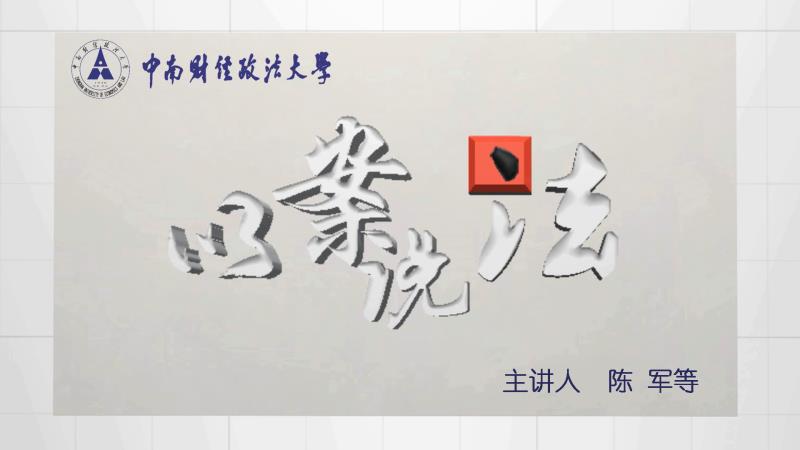
当前课程知识点:Methodology of Scientific Research > Lecture 5 Practical application of scientific research methods > Section 5.2 Analysis of Scientific Research Cases > 5.2.2 Example of Team Cooperation
返回《Methodology of Scientific Research》慕课在线视频课程列表
返回《Methodology of Scientific Research》慕课在线视频列表
我们接下来来讲一个案例
Let's talk about a case
就是团队合作案例
which is the case of teamwork
团队合作是科研的又一关键点
Teamwork is another key point of scientific research
团队合作包括内外两部分
Teamwork includes both internal and external parts
内部分工合作
and internal part of the work cooperation
要各自做好擅长的一面
each should do a good job
在外部要善于借助其他人的研究成果
To be good at using the research results of others from the outside
我们来看一下DNA双螺旋结构的发现
let's take a look at the discovery process of the DNA double helix structure
dna双螺旋结构
The DNA double helix structure
是分子生物学的一个里程碑突破
is a milestone breakthrough in molecular biology
他是1953年由沃森和克里克发现的
and was discovered by Watson and Crick in 1953
沃森生物学基础扎实
Watson ’s biology is solid
训练有素
and well-trained
克里克具有物理学优势
and Creek has physics advantages
又不受传统生物学观念束缚
Without being bound by traditional biological ideas
常以一种全新的视角来思考问题
they often think about issues from a new perspective
这就使得他们在内部形成了优势互补的研究小团队
This allows them to form a small research team with complementary advantages internally
而在外部他们充分吸收和借鉴
while they fully absorb and learn from the outside
当时也在研究DNA分子结构的刨林威尔金斯
Planlin Wilkins, who was also studying the molecular structure of DNA at that time
而弗兰克林等人的成果
borrowed from the results of Franklin and others
他们没有亲自做实验
Instead of doing experiments in person
而是利用其他研究小组的数据来构建 DNA模型
they used data from other research groups to construct DNA
那么其中关键一步是看到1952年弗兰克林DNA x衍射线照片
The key step is to see the DNA x-ray photo of Franklin in 1952
弗兰克林在法国学习了x射线衍射技术
Franklin studied x-ray diffraction technology in France
他通过从非常浓而粘稠的 DNA
he passed from very thick and sticky DNA
农业用针挑出 DNA
using a needle to pick up DNA in the solution
那么拉成纤维状
and pull it into a fibrous shape
这使得一大树DNA分子并肩整齐排列
this makes a large bundle of DNA molecules aligned side by side
那么自束纤维就足以向晶体那样产生可分析、阐述 x射线衍射
and the self-bundled fiber is enough to produce an analytically elaborate x-ray diffraction like a crystal
在下面的照片中
In the photo below
我们可以看到衍射图
we can see the diffraction pattern
非常的简单
which is a series of very simple points
是一系列的点排成的x形状,表明 DNA结构本身一定非常简单
The x shape lined up indicates that the DNA structure itself must be very simple
由于边a分之非常大
Since side a is very large
那么只有具备规则重复的结构
only with a regular repetitive structure.
我们才有可能获得简单的 x射线衍射照片
can we obtain simple x-ray diffraction pictures
因此沃森和克里克
Therefore, Watson and Creek
通过这个照片不仅确认了 DNA一定是螺旋结构
not only confirmed that the DNA must be a helix structure
而且分析得出了螺旋参数
but also analyzed the helix parameters
他们采用了富兰克林和威尔金斯的判断
They used Franklin and Wilkins' judgment
并加以补充
and added that
认为磷酸根在螺旋的外侧构成两条多核苷方面的方向是相反的
the direction of phosphate on the outside of the helix constitutes two polynucleosides in the opposite direction
43
碱基在螺旋内侧两两对应
The bases correspond to each other inside the helix
那么通过他们就完成了 DNA结构的结构
and through them, the DNA structure is completed.
那么可以说同一领域的研究同行
It can be said that the research peers in the same field
如同在一个松散的团队中
are as if they are in a loose team
因此我们要主动利用这种潜在或隐含的团队合作方式
so we should take the initiative to use this potential or implicit teamwork
开拓我们视野和激发思维
to expand our horizons and stimulate thinking
驱动科研的另外一个动力就是工程需求
Another driving force for scientific research is engineering demand
那么工程需求会促使我们寻找新方法和提炼
Engineering demand will prompt us to find new methods and refine scientific problems
科学问题同时又能让我们直接看到科研对社会的促进作用
while allowing us to directly see the role of scientific research in promoting society
在这里
Here
我将结合我们在美国堪萨斯大学所做的非侵入式偏振模色散测量方法这一个案例来进行介绍
I will introduce the case of the non-invasive polarization mode dispersion measurement method we made at the University of Kansas
我们知道光通信网络需要支持传输视频音频和数据
We know that the optical communication network needs to support the transmission of video
这是海量数据传输的需求,也就对光纤传输速率和质量都提出了要求
audio and data, which is a huge amount of data,the demand for massive data transmission also puts forward requirements on the fiber transmission rate and quality
因此
Therefore
光传输网络管理就需要我们获取准确的光纤链路参数来进行保障
the management of the optical transmission network requires us to obtain accurate fiber link parameters to ensure
在光纤中有多种机制
There are many mechanisms in optical fiber
都会影响到我们的传输质量
that affect transmission quality
偏振模色散
and polarization mode dispersion
其中一种
is one of them
那么我们通常简称为 pmd
We usually abbreviate it as pmd
把它想象成一个双折射晶体
and think of it as a birefringent crystal
那么它在相互垂直的快轴和慢轴上的折射力是
Its refractive power on the fast axis and the slow axis that are perpendicular to each other
不同的
are different
这就导致了这两个偏振方向的光速不同
This results in different speeds of light in both directions of polarization
我们可以看到这个图
We can see this picture
同时出发的一个脉冲
After a pulse that has been sent through a gear of fiber transmission at the same time
在经过一档光纤传输后
the pulses of the two polarization directions
两个偏振方向的脉通就走离分开
will go away
因此
Therefore
当我们采用强度探测的方式
when we use the intensity detection method
就发现脉冲展宽了
It is found that the pulse is widened
当变宽到一定程度
When it is widened to a certain extent
他就可能一味侵入到相邻的脉冲时间潮
it may invade the adjacent pulse time tide
导致我们读码错误
and cause us to read the code incorrectly
也就产生码间干扰
which will cause inter-code interference
使我们不能恢复出原始的输入数据
and prevent us from recovering the original
产生数据传输错误
input data Data transmission error
那么要解决这个问题
Therefore, to solve this problem
我们就要控制脉冲的走离程度
we must control the degree of deviation of the pulse
我们首先就要建立模型去分析它
we must first establish a model to analyze it
我们要分析光纤偏振演化模型
To analyze the fiber polarization evolution model
那么它的一个数学描述就是偏振赌态模型
one of its mathematical descriptions is the polarization state model
偏振态的快轴和慢轴的实验
The experiments of the fast axis and the slow axis of the polarization state
我们称为他分群实验
are called other group experiments
也即我们可以看到光纤电路可以等效为有很多个延迟相等
That is, we can see that the fiber circuit can be equivalent to many Delays are equal
但慢轴方位
However, the azimuth of the slow axis
随机分布
is randomly distributed and consists of paddles
且随时间变化的拨片构成
that change with time
因此总体的差分情实验需要根据统计学去计算
so the overall difference experiment needs to be calculated according to statistics
它应该遵循麦克斯韦两分布
It should follow Maxwell's two distributions
那么利用慢轴方向和差分情时延数值大小
Using the direction of the slow axis and the magnitude of the differential delay time
我们就可以定义构建pm的向量
we can define the vector that constructs pm
当我们固定输入偏振态的时候就发现改变输入光的光屏
When we fix the input polarization state
在邦伽球上的输入偏振态
we find that the light screen that changes the input light
就会围绕pmd向量进行一个旋转
the input polarization state on the Banjia sphere
那么光纤 pmd设善控制
will be performed a rotation around the PMD vector
就变成在于求取pmd向量
then the fiber PMD dispersion control becomes to find the PMD vector
那么传统的测量方法
Then the traditional measurement method
正是利用数学模型中展示出来的
is exactly shown in the mathematical model
就是围绕pmc向量这样的一个旋转特性
which is based on a rotation characteristic of the pmc vector
那么我们通过测量
We determine the low-level point of our time-saving value
在垂直pmd向量平面的这样的一个旋转夹角
by measuring such a rotation
Δθ来确定我们的省时值低级点
angle Δθ in the vertical pmd vector plane
然后我们通过连续测量大量的时间的测试结果来计算统计 pmd的大小
Then, we calculate the size of statistical pmd by continuously measuring the test results of a large amount of time.
那么具体的实现方式
Specific implementations include
包括重塑计算、邦伽球分析和米勒计算法
remodeling calculations、Bangjia ball analysis and Miller calculation methods
但是这些方法也存在一些缺点
But these methods also have some shortcomings
就是说你需要控制输入偏振态
that is, they need to control the input polarization state
需要从光纤两端进行接入
they need to be accessed from both ends of the fiber
需要对输入和输出进行同步
and they need to synchronize the input and output
那么最为关键的是不能用于正在进行正常商业
The most important thing is that they cannot be used in systems that are undergoing normal commercial data transmission
数据传输的系统
而我们当时要面对的工程测试需求
The engineering test needs to be faced at that time were
要克服最后一个问题
to overcome the last problem
那么后面一小节
In the following section
我们将阐述我们是如何对这个问题进行思考解决的
we will explain how we think about this problem
-Section 1.1 Basic Concepts of Scientific Research
--1.1.1 Basic Concepts of Research
-Section 1.2 General Procedure of Scientific Research
--1.2.3 Process of Natural Science
--1.2.4 Process of Social Science
--1.2.5 Process of Technologial Science
-Section 1.3 How to Prepare for Scientific Research
--1.3.1 Motivation of Research
-Test-Lecture #1
-Section 2.1 Types and Sources of Research Project
-Section 2.2 Principles and Methods of Topic Selection
--2.2.1 Principle of Topic Selection
--2.2.2 Methods of Topic Selection
--2.2.3 Procedure and Strategy of Topic Selection
-Section 2.3 Information Collection of Project
--2.3.1 Type, Collection and Search of Information
-Test-Lecture #2
-Section 3.1 Typical Research Methods
--3.1.1 Level of Research Method
--3.1.2 Concept of Research Method
--3.1.3 Typical Research Methods
-Section 3.2 Typical Thinking Modes
--3.2.1 Thinking and its Characteristics
--3.2.2 General Innovative Thinking
--3.2.3 Typical Thinking Modes
-Section 3.3 Analysis of Research Cases
--3.3.1 Question Description and Concept
--3.3.2 Three-Level Theory of Problem
--3.3.3 Train of Question Consciousness
-Test-Lecture #3
-Section 4.1 Research-oriented Scientific Design
--4.1.1 General Scientific Design
--4.1.3 Example of Research Design
--4.1.4 Other kinds of Research Design
-Section 4.2 Experimental Scientific Research Design
--4.2.4 Example of Experimental Design
-Section 4.3 Application-oriented Scientific Design
--4.3.1 Basic Concepts and Significance
--4.3.3 Example of Applied Design
--4.3.4 Train of Research Skills
-Test-Lecture #4
-Section 5.1 Initial Entry into the Research Group
--5.1.2 Consider Research Outline
-Section 5.2 Analysis of Scientific Research Cases
--5.2.1 Example of Correct Topic Selection
--5.2.2 Example of Team Cooperation
--5.2.3 Test of Non-invasive PDM
-Section 5.3 Research-based Learning and Research
--5.3.1 Overview of Research Learning
--5.3.2 Research-based Learning
--5.3.3 Research Train for Undergraduates
-Test-Lecture #5
-Section 6.1 Scientific Research Strategy and Tactics
--6.1.1 Strategy in Research Work
--6.1.2 Tactics in Research Work
--6.1.3 Research Group and Management
-Section 6.2 Scientific Research Tactful Operation
--6.2.3 Typical Research Planning
-Section 6.3 Discrimination of Research Obstruction
--6.3.2 Origin of Research Obstruction
--6.3.3 Case of Research Obstruction
--6.3.4 Strategy to Remove Obstruction
-Test-Lecture #6
-Section 7.1 Research Papers and Writing
--7.1.2 Writing Research Paper
-Section 7.2 Rules for Submission and Publication
--7.2.1 Preparing for Contribution
--7.2.2 Process of Publication
--7.2.3 Strategy of Contribution
-Section 7.3 Examples and Analysis of Paper
--7.3.1 Basic Structure of Paper
--7.3.3 Introduction, Main Content and Conclusion
-Test-Lecture #7
-Section 8.1 Introduction of Invention and Creation
--8.1.1 Generality of Invention
--8.1.2 Principle of Invention
--8.1.3 Risk and Protection of Invention
-Section 8.2 Patent Types and Applications
--8.2.1 Characteristics and Types of Patent
--8.2.3 Process of Applying Patent
-Section 8.3 Patent Examples and Analysis
--8.3.1 Example of Invention Patent
--8.3.2 Example of Utility Model Patent
--8.3.3 Example of Design Patent
-Test-Lecture #8
-Section 9.1 Characteristics, Types and Titles of Academic Conferences
--9.1.1 Characteristisc of Academic Conference
--9.1.2 Types of Academic Conference
--9.1.3 Title of Academic Conference
-Section 9.2 Basic Elements and Report Types of Academic Conferences
--9.2.1 Basic Elements of Conference
--9.2.2 Types of Conference Report
-Section 9.3 Main Points, Syntax and Summary of Academic Reports
--9.3.1 Writing and Accepting Conference Paper
--9.3.2 Exercise before Reporting
-Test-Lecture #9
-Section 10.1 Character and Type of Researcher
--10.1.1 Basic Moral of Researcher
--10.1.2 Moral Outlook of Researcher
--10.1.3 Talent Type and Innovative Quality
-Section 10.2 Research Ethics and Academic Norms
--10.2.1 Generality of Research Morality
--10.2.3 Monitoring Measure of Research
-Section 10.3 Research Relationship and Incentive Mechanism
--10.3.1 Generality of Research Relation
--10.3.2 Typical Research Relation
--10.3.3 Research Incentive System
-Test-Lecture #10

